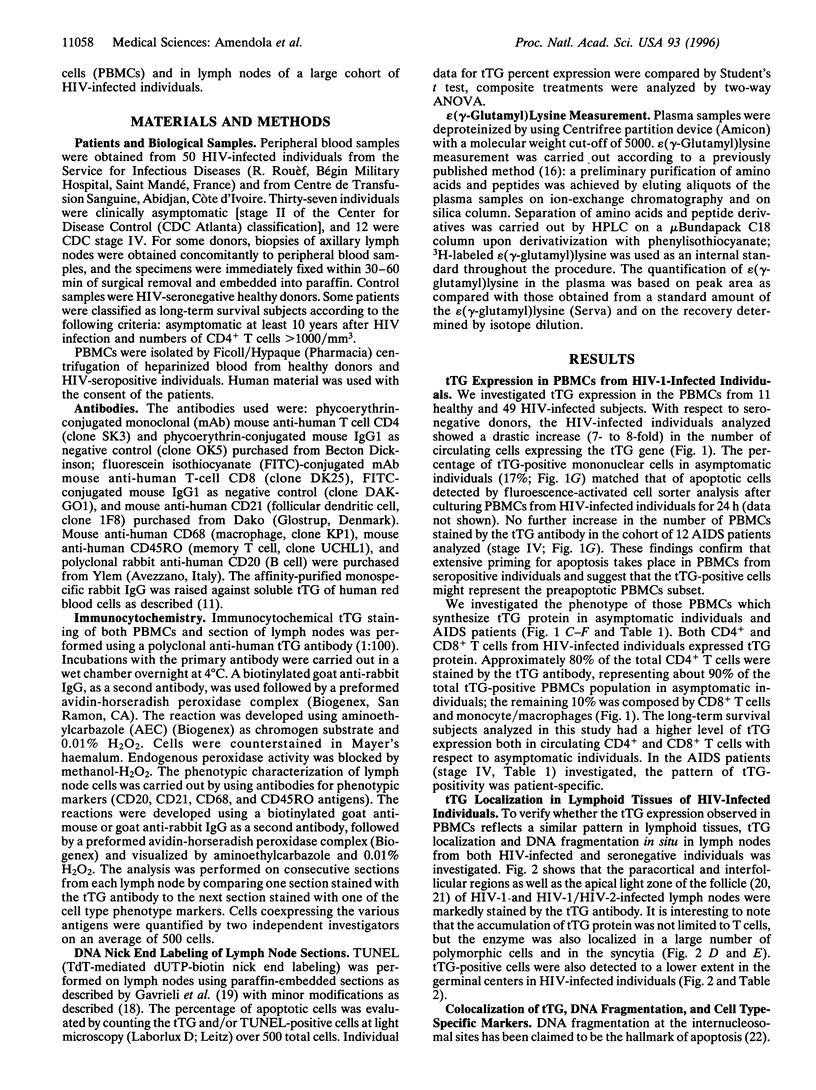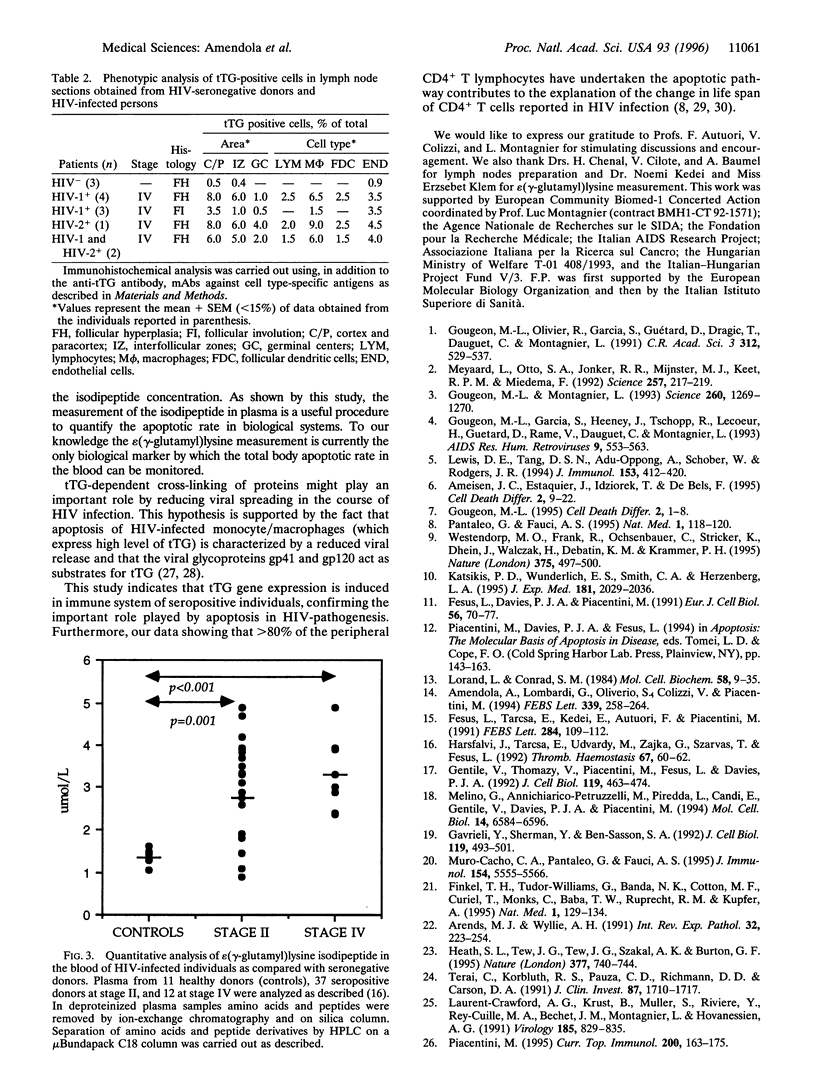Abstract
Peripheral blood mononuclear cells and lymphoid tissues from HIV-infected individuals display high levels of "tissue" transglutaminase (tTG) with respect to seronegative persons. In asymptomatic individuals, > 80% of the circulating CD4+ T cells synthesize tTG protein and the number of these cells matches the level of apoptosis detected in the peripheral blood mononuclear cells from the same patients. In HIV-infected lymph nodes tTG protein is localized in large number of cells (macrophages, follicular dendritic cells, and endothelial cells), showing distinctive morphological and biochemical features of apoptosis as well as in lymphocytes and syncytia. These findings demonstrate that during the course of HIV infection, high levels of apoptosis also occur in the accessory cells of lymphoid organs. The increased concentration of epsilon(gamma-glutamyl)lysine isodipeptide, the degradation product of tTG cross-linked proteins, observed in the blood of HIV-infected individuals demonstrates that the enzyme accumulated in the dying cells actively cross-links intracellular proteins. The enhanced levels of epsilon(gamma-glutamyl)lysine in the blood parallels the progression of HIV disease, suggesting that the isodipeptide determination might be a useful method to monitor the in vivo rate of apoptosis.
Full text
PDF





Images in this article
Selected References
These references are in PubMed. This may not be the complete list of references from this article.
- Ameisen J. C., Estaquier J., Idziorek T., De Bels F. Programmed cell death and AIDS: significance, perspectives and unanswered questions. Cell Death Differ. 1995 Jan;2(1):9–22. [PubMed] [Google Scholar]
- Amendola A., Lombardi G., Oliverio S., Colizzi V., Piacentini M. HIV-1 gp120-dependent induction of apoptosis in antigen-specific human T cell clones is characterized by 'tissue' transglutaminase expression and prevented by cyclosporin A. FEBS Lett. 1994 Feb 21;339(3):258–264. doi: 10.1016/0014-5793(94)80427-3. [DOI] [PubMed] [Google Scholar]
- Arends M. J., Wyllie A. H. Apoptosis: mechanisms and roles in pathology. Int Rev Exp Pathol. 1991;32:223–254. doi: 10.1016/b978-0-12-364932-4.50010-1. [DOI] [PubMed] [Google Scholar]
- Bergamini A., Capozzi M., Piacentini M. Macrophage-colony stimulating factor (M-CSF) stimulation induces cell death in HIV-infected human monocytes. Immunol Lett. 1994 Sep;42(1-2):35–40. doi: 10.1016/0165-2478(94)90032-9. [DOI] [PubMed] [Google Scholar]
- Fesus L., Tarcsa E., Kedei N., Autuori F., Piacentini M. Degradation of cells dying by apoptosis leads to accumulation of epsilon(gamma-glutamyl)lysine isodipeptide in culture fluid and blood. FEBS Lett. 1991 Jun 17;284(1):109–112. doi: 10.1016/0014-5793(91)80773-v. [DOI] [PubMed] [Google Scholar]
- Finkel T. H., Tudor-Williams G., Banda N. K., Cotton M. F., Curiel T., Monks C., Baba T. W., Ruprecht R. M., Kupfer A. Apoptosis occurs predominantly in bystander cells and not in productively infected cells of HIV- and SIV-infected lymph nodes. Nat Med. 1995 Feb;1(2):129–134. doi: 10.1038/nm0295-129. [DOI] [PubMed] [Google Scholar]
- Gavrieli Y., Sherman Y., Ben-Sasson S. A. Identification of programmed cell death in situ via specific labeling of nuclear DNA fragmentation. J Cell Biol. 1992 Nov;119(3):493–501. doi: 10.1083/jcb.119.3.493. [DOI] [PMC free article] [PubMed] [Google Scholar]
- Gentile V., Thomazy V., Piacentini M., Fesus L., Davies P. J. Expression of tissue transglutaminase in Balb-C 3T3 fibroblasts: effects on cellular morphology and adhesion. J Cell Biol. 1992 Oct;119(2):463–474. doi: 10.1083/jcb.119.2.463. [DOI] [PMC free article] [PubMed] [Google Scholar]
- Gougeon M. L. Does apoptosis contribute to CD4 T cell depletion in human immunodeficiency virus infection ? Cell Death Differ. 1995 Jan;2(1):1–8. [PubMed] [Google Scholar]
- Gougeon M. L., Garcia S., Heeney J., Tschopp R., Lecoeur H., Guetard D., Rame V., Dauguet C., Montagnier L. Programmed cell death in AIDS-related HIV and SIV infections. AIDS Res Hum Retroviruses. 1993 Jun;9(6):553–563. doi: 10.1089/aid.1993.9.553. [DOI] [PubMed] [Google Scholar]
- Gougeon M. L., Montagnier L. Apoptosis in AIDS. Science. 1993 May 28;260(5112):1269–1270. doi: 10.1126/science.8098552. [DOI] [PubMed] [Google Scholar]
- Gougeon M. L., Olivier R., Garcia S., Guetard D., Dragic T., Dauguet C., Montagnier L. Mise en évidence d'un processus d'engagement vers la mort cellulaire par apoptose dans les lymphocytes de patients infectés par le VIH. C R Acad Sci III. 1991;312(11):529–537. [PubMed] [Google Scholar]
- Harsfalvi J., Tarcsa E., Udvardy M., Zajka G., Szarvas T., Fesus L. Presence and possible origin of epsilon(gamma-glutamyl)lysine isodipeptide in human plasma. Thromb Haemost. 1992 Jan 23;67(1):60–62. [PubMed] [Google Scholar]
- Heath S. L., Tew J. G., Tew J. G., Szakal A. K., Burton G. F. Follicular dendritic cells and human immunodeficiency virus infectivity. Nature. 1995 Oct 26;377(6551):740–744. doi: 10.1038/377740a0. [DOI] [PubMed] [Google Scholar]
- Ho D. D., Neumann A. U., Perelson A. S., Chen W., Leonard J. M., Markowitz M. Rapid turnover of plasma virions and CD4 lymphocytes in HIV-1 infection. Nature. 1995 Jan 12;373(6510):123–126. doi: 10.1038/373123a0. [DOI] [PubMed] [Google Scholar]
- Katsikis P. D., Wunderlich E. S., Smith C. A., Herzenberg L. A., Herzenberg L. A. Fas antigen stimulation induces marked apoptosis of T lymphocytes in human immunodeficiency virus-infected individuals. J Exp Med. 1995 Jun 1;181(6):2029–2036. doi: 10.1084/jem.181.6.2029. [DOI] [PMC free article] [PubMed] [Google Scholar]
- Laurent-Crawford A. G., Krust B., Muller S., Rivière Y., Rey-Cuillé M. A., Béchet J. M., Montagnier L., Hovanessian A. G. The cytopathic effect of HIV is associated with apoptosis. Virology. 1991 Dec;185(2):829–839. doi: 10.1016/0042-6822(91)90554-o. [DOI] [PubMed] [Google Scholar]
- Lewis D. E., Tang D. S., Adu-Oppong A., Schober W., Rodgers J. R. Anergy and apoptosis in CD8+ T cells from HIV-infected persons. J Immunol. 1994 Jul 1;153(1):412–420. [PubMed] [Google Scholar]
- Lorand L., Conrad S. M. Transglutaminases. Mol Cell Biochem. 1984;58(1-2):9–35. doi: 10.1007/BF00240602. [DOI] [PubMed] [Google Scholar]
- Mariniello L., Esposito C., Di Pierro P., Cozzolino A., Pucci P., Porta R. Human-immunodeficiency-virus transmembrane glycoprotein gp41 is an amino acceptor and donor substrate for transglutaminase in vitro. Eur J Biochem. 1993 Jul 1;215(1):99–104. doi: 10.1111/j.1432-1033.1993.tb18011.x. [DOI] [PubMed] [Google Scholar]
- Melino G., Annicchiarico-Petruzzelli M., Piredda L., Candi E., Gentile V., Davies P. J., Piacentini M. Tissue transglutaminase and apoptosis: sense and antisense transfection studies with human neuroblastoma cells. Mol Cell Biol. 1994 Oct;14(10):6584–6596. doi: 10.1128/mcb.14.10.6584. [DOI] [PMC free article] [PubMed] [Google Scholar]
- Meyaard L., Otto S. A., Jonker R. R., Mijnster M. J., Keet R. P., Miedema F. Programmed death of T cells in HIV-1 infection. Science. 1992 Jul 10;257(5067):217–219. doi: 10.1126/science.1352911. [DOI] [PubMed] [Google Scholar]
- Muro-Cacho C. A., Pantaleo G., Fauci A. S. Analysis of apoptosis in lymph nodes of HIV-infected persons. Intensity of apoptosis correlates with the general state of activation of the lymphoid tissue and not with stage of disease or viral burden. J Immunol. 1995 May 15;154(10):5555–5566. [PubMed] [Google Scholar]
- Pantaleo G., Fauci A. S. Apoptosis in HIV infection. Nat Med. 1995 Feb;1(2):118–120. doi: 10.1038/nm0295-118. [DOI] [PubMed] [Google Scholar]
- Piacentini M. Tissue transglutaminase: a candidate effector element of physiological cell death. Curr Top Microbiol Immunol. 1995;200:163–175. doi: 10.1007/978-3-642-79437-7_12. [DOI] [PubMed] [Google Scholar]
- Terai C., Kornbluth R. S., Pauza C. D., Richman D. D., Carson D. A. Apoptosis as a mechanism of cell death in cultured T lymphoblasts acutely infected with HIV-1. J Clin Invest. 1991 May;87(5):1710–1715. doi: 10.1172/JCI115188. [DOI] [PMC free article] [PubMed] [Google Scholar]
- Wei X., Ghosh S. K., Taylor M. E., Johnson V. A., Emini E. A., Deutsch P., Lifson J. D., Bonhoeffer S., Nowak M. A., Hahn B. H. Viral dynamics in human immunodeficiency virus type 1 infection. Nature. 1995 Jan 12;373(6510):117–122. doi: 10.1038/373117a0. [DOI] [PubMed] [Google Scholar]
- Westendorp M. O., Frank R., Ochsenbauer C., Stricker K., Dhein J., Walczak H., Debatin K. M., Krammer P. H. Sensitization of T cells to CD95-mediated apoptosis by HIV-1 Tat and gp120. Nature. 1995 Jun 8;375(6531):497–500. doi: 10.1038/375497a0. [DOI] [PubMed] [Google Scholar]




